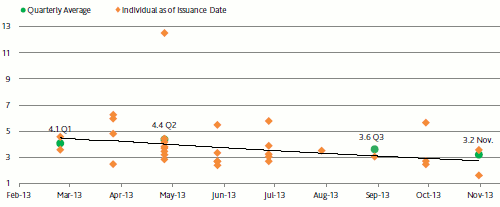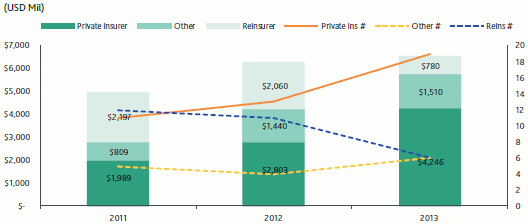The growing size of the catastrophe bond market, which at around $20 billion of risk capital outstanding has reached its largest size ever, is a credit negative factor the outlook of reinsurers, according to a report from ratings agency Moody’s.
The size of the catastrophe bond market, which has grown in outright terms by nearly $3.5 billion or approximately 20% in just one year, shows the increasing interest that capital market investors have in participating in catastrophe reinsurance business.
As interest among investors continues to grow, the share of the global property catastrophe reinsurance market which is financed by third-party capital increases and this trend is now taking away core reinsurance business opportunities from traditional reinsurers. As investors get a taste for new lines of business and new layers of risk, while the market adapts and innovates to support these tastes, the outlook for reinsurers looks pessimistic.
At the end of 2013 the outstanding catastrophe bond market will reach the largest size in its 16 or so year history. In a report published yesterday, Moody’s puts the expected size of the market a year-end at just under $20 billion. However, since the Moody’s report was written we now have two more deals bringing another $500m or more of risk capital, so over $20 billion now seems more likely.
Moody’s says that the expansion of the asset class, driven by continued demand from hedge funds, pension funds and other institutional investors who have embraced catastrophe risk and reinsurance as an asset class for return and diversification benefits, looks likely to continue for the forseeable future.
Moody’s says that this is credit negative for reinsurance companies, as catastrophe bonds create competition for traditional reinsurance and the cat bond market is increasingly making efforts to widen peril coverage and terms across a range of geographies and risk categories.
Moody’s said that the increasing volume of cat bonds issued and outstanding is generally credit negative for reinsurers, as insurance-linked securities (ILS) compete directly with traditional reinsurance products. This has resulted in core areas of catastrophe reinsurance programs being taken by capital market investors, while traditional reinsurers have been forced to look elsewhere for opportunities, in some cases diversifying away from catastrophe risks.
Moody’s notes a number of factors which have helped the catastrophe bond market continue its recent strong momentum through 2013.
Firstly, pricing on cat bond issuances have compressed meaningfully. With demand continuing to outstrip supply pricing has continued to decline through 2013, with the average spread premium to expected loss multiple coming down over the course of the year. The multiple has declined from 4.1x in Q1 2013, to 3.2x in early Q4, according to analysis Moody’s undertook using data from the Artemis Deal Directory.

Multiple of Spread Premium to Expected Loss (Non-Life) - Source: Artemis Deal Directory
If you compare the decline in premium to expected loss multiples over the last year, from quarter to quarter 2012 to 2013, the decline is particularly pronounced. Moody’s compared pricing for four non-life cat bond repeat issuers, from their 2012 deal to their 2013 cat bonds. Moody’s observed an average decline in pricing, as measured by the multiple, of 46% across the four issuers.

Ratio of Spread Premium to Expected Loss (SSST) - Source: Artemis Deal Directory; Lane Financials Annual Report
This demand from investors is expected to continue through the January renewal season, meaning cat bond sponsors may be able to secure attractive terms for their reinsurance coverage if opting to tap the capital markets. All recent cat bond transactions have priced below or at, the mid-range of initial price guidance, showing that there may be room for pricing to decline a little further.
Secondly, the cat bond market has been slowly expanding in terms of perils and geographies covered. Moody’s said that cat bond issuance is broadening geographically, as issuers’ interest in cat bonds has moved to new regions of the world. We’ve also seen the coverage offered by cat bonds expand, as structurers have found new ways to add unusual risks to cat bonds and to offer sponsors more flexibility through features such as variable resets.
Thirdly, the issuer base for catastrophe bonds is expanding, notes Moody’s. The issuer base is expanding beyond just private insurance firms, said Moody’s, citing the MetroCat Re cat bond from the New York Mass Transit Authority and Bosphorus 1 Re from the Turkish Catastrophe Insurance Pool.
The ability of corporations and public entities to access the capital markets through instruments such as catastrophe bonds for re/insurance protection is reducing the amount of risk available to traditional reinsurance firms, said Moody’s. This trend is credit negative for reinsurance companies who are increasingly having to compete against new and lower cost capacity across a widening range of business.
In terms of who issues the most risk to the cat bond market, insurers continue to lead the way, while reinsurers participation as sponsors has declined and others (including corporations, public, state-run and non-insurers) has grown. Moody’s analysis shows that the dollar volume of cat bond issuance from insurers has increased by 113% since 2011, while the amount sponsored by reinsurers has decreased by 64%. The ‘others’ bucket has grown strongly and in 2013 accounted for around double the risk capital issued by reinsurers.

Number of Issuers and Nominal Volume of their Issuances both Life and Non-Life - Source: Artemis Deal Directory
Moody’s notes in its report that traditional reinsurers are increasingly establishing capital markets units as they adjust business strategies to adapt to the changing market and to take advantage of alternative reinsurance capital. While reinsurers use of catastrophe bonds for retrocession may have declined in 2013, their involvement in third-party capital as asset managers has grown strongly.
Moody’s closes the report by saying that it expects the share of alternative capital in the reinsurance sector will continue grow, applying further pressure on reinsurers to adapt to the changing market environment.
It will become clearer in 2014 how effective reinsurers third-party capital activities are. At some point next year, numbers such as expense ratios are going to become hot topics of conversation for reinsurers as they continue to compete with more efficient capital markets money and managers.
Moving risk into reinsurer managed third-party capital vehicles at lower pricing to compete with ILS and alternative capital will eventually show up the efficiency that pure ILS players have found. 2014 is going to be an interesting year for reinsurers quarterly results, particularly from the middle of the year onwards as recent trends begin to be more strongly reflected in balance sheet results.
Subscribers can access the full report, or non-subscribers can purchase it, from the Moody’s website here.
 View all of our Artemis Live video interviews and subscribe to our podcast.
View all of our Artemis Live video interviews and subscribe to our podcast.
All of our Artemis Live insurance-linked securities (ILS), catastrophe bonds and reinsurance video content and video interviews can be accessed online.
Our Artemis Live podcast can be subscribed to using the typical podcast services providers, including Apple, Google, Spotify and more.































